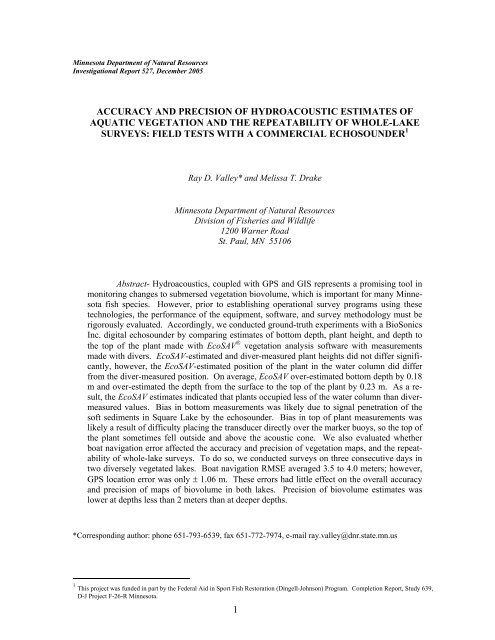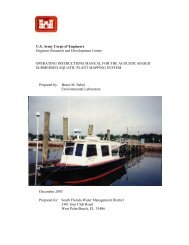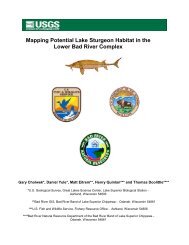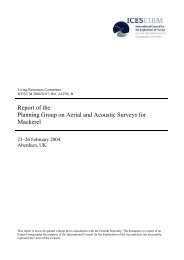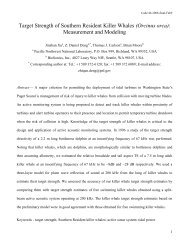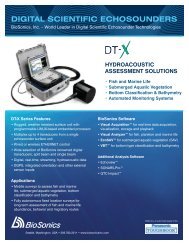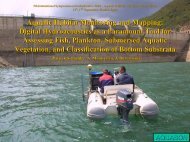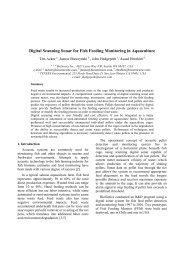Accuracy and Precision of Hydroacoustic Estimates ... - BioSonics, Inc
Accuracy and Precision of Hydroacoustic Estimates ... - BioSonics, Inc
Accuracy and Precision of Hydroacoustic Estimates ... - BioSonics, Inc
Create successful ePaper yourself
Turn your PDF publications into a flip-book with our unique Google optimized e-Paper software.
Minnesota Department <strong>of</strong> Natural Resources<br />
Investigational Report 527, December 2005<br />
ACCURACY AND PRECISION OF HYDROACOUSTIC ESTIMATES OF<br />
AQUATIC VEGETATION AND THE REPEATABILITY OF WHOLE-LAKE<br />
SURVEYS: FIELD TESTS WITH A COMMERCIAL ECHOSOUNDER 1<br />
Ray D. Valley* <strong>and</strong> Melissa T. Drake<br />
Minnesota Department <strong>of</strong> Natural Resources<br />
Division <strong>of</strong> Fisheries <strong>and</strong> Wildlife<br />
1200 Warner Road<br />
St. Paul, MN 55106<br />
Abstract- <strong>Hydroacoustic</strong>s, coupled with GPS <strong>and</strong> GIS represents a promising tool in<br />
monitoring changes to submersed vegetation biovolume, which is important for many Minnesota<br />
fish species. However, prior to establishing operational survey programs using these<br />
technologies, the performance <strong>of</strong> the equipment, s<strong>of</strong>tware, <strong>and</strong> survey methodology must be<br />
rigorously evaluated. Accordingly, we conducted ground-truth experiments with a <strong>BioSonics</strong><br />
<strong>Inc</strong>. digital echosounder by comparing estimates <strong>of</strong> bottom depth, plant height, <strong>and</strong> depth to<br />
the top <strong>of</strong> the plant made with EcoSAV ® vegetation analysis s<strong>of</strong>tware with measurements<br />
made with divers. EcoSAV-estimated <strong>and</strong> diver-measured plant heights did not differ significantly,<br />
however, the EcoSAV-estimated position <strong>of</strong> the plant in the water column did differ<br />
from the diver-measured position. On average, EcoSAV over-estimated bottom depth by 0.18<br />
m <strong>and</strong> over-estimated the depth from the surface to the top <strong>of</strong> the plant by 0.23 m. As a result,<br />
the EcoSAV estimates indicated that plants occupied less <strong>of</strong> the water column than divermeasured<br />
values. Bias in bottom measurements was likely due to signal penetration <strong>of</strong> the<br />
s<strong>of</strong>t sediments in Square Lake by the echosounder. Bias in top <strong>of</strong> plant measurements was<br />
likely a result <strong>of</strong> difficulty placing the transducer directly over the marker buoys, so the top <strong>of</strong><br />
the plant sometimes fell outside <strong>and</strong> above the acoustic cone. We also evaluated whether<br />
boat navigation error affected the accuracy <strong>and</strong> precision <strong>of</strong> vegetation maps, <strong>and</strong> the repeatability<br />
<strong>of</strong> whole-lake surveys. To do so, we conducted surveys on three consecutive days in<br />
two diversely vegetated lakes. Boat navigation RMSE averaged 3.5 to 4.0 meters; however,<br />
GPS location error was only ± 1.06 m. These errors had little effect on the overall accuracy<br />
<strong>and</strong> precision <strong>of</strong> maps <strong>of</strong> biovolume in both lakes. <strong>Precision</strong> <strong>of</strong> biovolume estimates was<br />
lower at depths less than 2 meters than at deeper depths.<br />
*Corresponding author: phone 651-793-6539, fax 651-772-7974, e-mail ray.valley@dnr.state.mn.us<br />
1 This project was funded in part by the Federal Aid in Sport Fish Restoration (Dingell-Johnson) Program. Completion Report, Study 639,<br />
D-J Project F-26-R Minnesota.<br />
1
INTRODUCTION<br />
Submersed aquatic vegetation provides<br />
critical habitat for numerous Minnesota fish<br />
species <strong>and</strong> is an integral component <strong>of</strong> fish<br />
community integrity (Valley et al. 2004;<br />
Drake <strong>and</strong> Valley 2005). The cumulative effects<br />
<strong>of</strong> lakeshore <strong>and</strong> watershed development<br />
has had negative effects on fish communities<br />
in the upper Midwest (Christensen et al. 1996;<br />
Jennings et al. 1999; Radomski <strong>and</strong> Goeman<br />
2001; Drake <strong>and</strong> Valley 2005). Unfortunately,<br />
habitat assessment techniques have lagged<br />
behind impacts occurring to lake habitats,<br />
<strong>and</strong> spatially explicit quantitative data on the<br />
distribution <strong>of</strong> aquatic vegetation in lakes is<br />
lacking. <strong>Hydroacoustic</strong>s coupled with differentially<br />
corrected GPS, analyzed in a GIS<br />
represents a promising new tool in the acquisition<br />
<strong>of</strong> important habitat data (Valley et al.<br />
2005).<br />
<strong>Hydroacoustic</strong>s has been an effective<br />
tool for assessing the abundance <strong>of</strong> submersed<br />
aquatic vegetation for some time (Maceina<br />
<strong>and</strong> Shireman 1980; Duarte 1987; Thomas et<br />
al. 1990). However, until the advent <strong>of</strong> global<br />
positioning systems (GPS) in the 1990s, our<br />
abilities to map the distribution <strong>of</strong> vegetation<br />
was greatly limited. Sabol <strong>and</strong> Melton (1995)<br />
describe an automated hydroacoustic system<br />
coupled with GPS to estimate bottom depth,<br />
vegetation cover, <strong>and</strong> vegetation height at<br />
numerous georeferenced locations. This system<br />
(a <strong>BioSonics</strong> <strong>Inc</strong>. digital echosounder,<br />
GPS, <strong>and</strong> bottom/plant detection algorithm)<br />
was originally termed the Submersed Aquatic<br />
Vegetation Early Warning System (SAVEWS;<br />
Sabol <strong>and</strong> Melton 1995). Tests on the performance<br />
<strong>of</strong> this system <strong>and</strong> algorithm have<br />
been performed in some hard bottom riverine<br />
<strong>and</strong> estuarine systems, <strong>and</strong> demonstrated high<br />
precision <strong>and</strong> accuracy in those environments<br />
(Sabol <strong>and</strong> Johnston 2001; Sabol et al.<br />
2002a,b).<br />
<strong>BioSonics</strong> <strong>Inc</strong>. has a Cooperative Research<br />
<strong>and</strong> Development Agreement with the<br />
Corps <strong>of</strong> Engineers for development <strong>and</strong> distribution<br />
<strong>of</strong> the patented vegetation detection<br />
algorithm marketed under the trade name<br />
EcoSAV ® . Using characteristics <strong>of</strong> the acoustic<br />
signal, EcoSAV uses a multi-step algorithm<br />
with user-defined parameter settings to determine<br />
depth, plant presence, plant absence, <strong>and</strong><br />
plant height (<strong>BioSonics</strong> <strong>Inc</strong>. 2002). EcoSAV<br />
1.2 processes <strong>BioSonics</strong> echosounder files <strong>and</strong><br />
creates an ASCII text file with records for<br />
every GPS report (recorded every 2 seconds).<br />
Each <strong>of</strong> these records includes a collection <strong>of</strong><br />
pings (number dependent on user-defined ping<br />
rates) where vegetation attributes are averaged<br />
between GPS reports (<strong>BioSonics</strong> <strong>Inc</strong>. 2002).<br />
Evaluating multiple pings per data record is<br />
critical for confidently identifying bottom in<br />
dense plants, where signal can periodically be<br />
attenuated in the plant canopy (Sabol <strong>and</strong><br />
Johnstone 2001).<br />
Because this system holds promise for<br />
assessing <strong>and</strong> mapping vegetated habitats (i.e.,<br />
a window to see littoral zones as l<strong>and</strong>scapes;<br />
Wiens 2002), we tested the performance <strong>of</strong><br />
<strong>BioSonics</strong> echosounders <strong>and</strong> EcoSAV in two<br />
Minnesota lakes. This involved a ground-truth<br />
experiment <strong>and</strong> a comparison <strong>of</strong> repeated wholelake<br />
surveys. First, we compared divermeasured<br />
depth <strong>and</strong> plant height with Eco-<br />
SAV-estimated depth <strong>and</strong> plant height for a<br />
variety <strong>of</strong> individual plant species (henceforth<br />
referred to as “fixed-point experiments”). Our<br />
analysis differs from that by Sabol et al.<br />
(2002) because we evaluate precision <strong>of</strong> estimates<br />
for single plants rather than comparing<br />
average signal returns with average field<br />
measurements. This alternative approach is<br />
necessary because EcoSAV uses a collection <strong>of</strong><br />
single plant measures, averaged between GPS<br />
records, in its reports <strong>of</strong> plant height. We<br />
sought to quantify the error going into these<br />
average measures.<br />
In addition, we evaluated the repeatability<br />
<strong>of</strong> whole-lake surveys. This is important<br />
to quantify because plant habitats in<br />
Minnesota lakes are highly diverse, <strong>and</strong> boat<br />
navigation error precludes sample transects<br />
from being precisely where intended. Local<br />
variability in plant height may affect the robustness<br />
<strong>of</strong> these surveys to boat navigation<br />
error. We assessed local- <strong>and</strong> lake-wide effects<br />
<strong>of</strong> sampling error by repeating three surveys<br />
on two lakes with methods described by<br />
Valley et al. (2005; henceforth referred to as<br />
“whole-lake surveys”). We quantified navigation<br />
<strong>and</strong> location error, the accuracy <strong>and</strong> precision<br />
<strong>of</strong> biovolume maps, <strong>and</strong> the repeatability<br />
<strong>of</strong> survey results.<br />
2
Percent vegetation biovolume is a<br />
habitat metric that has previously been referred<br />
to as Percent Vertical Area Infestation<br />
or Percent Volume Infestation (Maceina <strong>and</strong><br />
Shireman 1980; Canfield et al. 1984). This<br />
quantity is estimated by planimetry <strong>of</strong> vegetated<br />
areas displayed by hydroacoustic transect<br />
echograms (Maceina <strong>and</strong> Shireman 1980;<br />
Canfield et al. 1984) or by dividing plant<br />
height by water depth <strong>and</strong> multiplying by percent<br />
cover (Schriver et al. 1995; Burks et al.<br />
2001). EcoSAV does not estimate biovolume<br />
as described by Maceina <strong>and</strong> Shireman (1980),<br />
but reports measures <strong>of</strong> plant height, water<br />
depth, <strong>and</strong> percent cover (frequency <strong>of</strong> plant<br />
occurrence along a transect). These data provided<br />
us a means by which to estimate biovolume.<br />
METHODS<br />
Study site−Fixed-point experiments<br />
were conducted in Square Lake (Washington<br />
Co.; 45°09’ N -93°48’ W) during July 2003.<br />
Square Lake is 79 ha <strong>and</strong> exhibits a diversity<br />
<strong>of</strong> native plant species (submersed species<br />
richness = 19 spp.) including several broad<br />
<strong>and</strong> narrow-leaved pondweeds Potamogeton<br />
spp., coontail Ceratophyllum demersum,<br />
northern watermilfoil Myriophyllum sibiricum<br />
<strong>and</strong> the macroalgae chara Chara sp. A diversity<br />
<strong>of</strong> depths (ranging from 1 to 8 m) <strong>and</strong><br />
plant species were surveyed. For the wholelake<br />
surveys, repeated surveys were conducted<br />
in Square Lake on three consecutive days during<br />
August 2002. Three repeated surveys<br />
were also carried out in Christmas Lake (Hennepin<br />
Co. 44°54’ N -93°32 W; 104 ha) during<br />
August 2003. Macrophytes in Christmas Lake<br />
are also diverse (submersed species richness =<br />
23 spp.), <strong>and</strong> include the canopy-growing<br />
Eurasian watermilfoil M. spicatum that creates<br />
high biovolume variability throughout the<br />
lake.<br />
Sampling equipment−<strong>Hydroacoustic</strong><br />
data were collected with a <strong>BioSonics</strong> DE-6000<br />
digital echosounder equipped with a 430 kHz<br />
6° split-beam transducer. For the fixed-point<br />
experiments <strong>and</strong> the whole-lake surveys, we<br />
set ping rates at 5 monotone pulses per second<br />
with a pulse-width <strong>of</strong> 0.1 milliseconds. Ping<br />
data were analyzed with EcoSAV version<br />
1.2.5.1. Unlike the commercially available<br />
version <strong>of</strong> EcoSAV, this modified beta version<br />
allowed us to evaluate vegetation attributes for<br />
individual pings. For the fixed-point experiments,<br />
default parameter settings for plant<br />
analyses in EcoSAV were used with exceptions<br />
that the threshold for plant detection<br />
parameter setting was decreased from the<br />
default –65 to –75 dB for increased sensitivity,<br />
plant detection persistence distance was<br />
increased from 0.09 m to 0.14 m, <strong>and</strong> bottom<br />
thickness threshold was increased from 0.21<br />
m to 0.25 m because <strong>of</strong> s<strong>of</strong>t sediments. For<br />
detailed descriptions <strong>of</strong> the EcoSAV algorithm<br />
<strong>and</strong> its parameters consult the EcoSAV<br />
user manual, available from <strong>BioSonics</strong> <strong>Inc</strong>.<br />
(www.biosonicsinc. com).<br />
Fixed-point experiments–Divers located<br />
<strong>and</strong> marked with numbered buoys, multiple<br />
littoral zone microhabitats exhibiting a<br />
variety <strong>of</strong> cover types, ranging from monotypic<br />
st<strong>and</strong>s <strong>of</strong> dense vegetation, to diverse<br />
st<strong>and</strong>s, to long, solitary coontail or whitestem<br />
pondweed P. praelongus growing at the edge<br />
<strong>of</strong> the littoral zone. At the surface, divers held<br />
the transducer in place directly over the area<br />
marked by the buoy <strong>and</strong> the area was pinged<br />
numerous times until a consistent signal directly<br />
over the targeted area was achieved.<br />
After each <strong>of</strong> the buoy sites were pinged, divers<br />
marked four corners <strong>of</strong> the ensonified<br />
area with marker buoys. The four buoy strings<br />
were held together at the surface by one diver,<br />
thus creating a pyramid-shaped sampling area,<br />
approximately equal to the size <strong>and</strong> shape <strong>of</strong><br />
the acoustic cone. The second diver descended<br />
to the bottom, identified the tallest<br />
plant intercepting the simulated cone, <strong>and</strong><br />
marked its length on a buoy string. Bottom<br />
depth at the sediment-plant interface <strong>and</strong> plant<br />
height were recorded at each sampling station<br />
by a diver. Bottom depth <strong>and</strong> plant height<br />
were also recorded with the echosounder <strong>and</strong><br />
EcoSAV. To account for the minor vagaries <strong>of</strong><br />
a stationary acoustic signal (i.e., ambient in<br />
situ noise has a small effect the backscattering<br />
<strong>of</strong> an acoustic signal), the mean depth <strong>and</strong><br />
plant height from a collection <strong>of</strong> 8 – 241 pings<br />
at each fixed-point were calculated. St<strong>and</strong>ard<br />
deviations were calculated to determine the<br />
quality (i.e., precision) <strong>of</strong> each acoustic estimates<br />
at each fixed-point. One-sample t-tests<br />
3
evaluating the null hypothesis that differences<br />
between diver-measured <strong>and</strong> EcoSAVestimated<br />
depths <strong>and</strong> plant heights were zero<br />
(α = 0.05).<br />
Whole-lake surveys–We completed<br />
three mapping runs on consecutive days, targeting<br />
the same GPS transects using a Garmin<br />
® GPSmap 76 h<strong>and</strong>held GPS unit with<br />
WAAS (Wide Area Augmentation System)<br />
differential-correction enabled. We mapped<br />
biovolume using methods described by Valley<br />
et al. (2005). Briefly summarized, this entailed<br />
collecting hydroacoustic vegetation data<br />
over transects perpendicular to the longest<br />
shoreline spaced 10 m apart. Boat speed was<br />
2 – 4 knots, separating DGPS reports every 3<br />
– 5 meters. This represented the distance<br />
between data records <strong>and</strong> defined the size <strong>of</strong><br />
the ping cycles (typically 10-11 pings per<br />
cycle). EcoSAV records one data location for<br />
each record as the mid point between GPS<br />
cycle boundaries. From the plant variables<br />
reported by EcoSAV, we calculated percent<br />
biovolume for each ping cycle using the following<br />
formula:<br />
Biovolume (%) =<br />
⎛ PlantHeight<br />
⎜<br />
⎝ Depth<br />
⎟<br />
⎠<br />
⎞<br />
x Plant Cover<br />
where: PlantHeight = the mean plant height<br />
for only those pings signaling the presence <strong>of</strong><br />
plants; Depth = a best depth estimate for a<br />
ping cycle determined from a patented heuristic<br />
algorithm (Sabol <strong>and</strong> Johnston 2001); <strong>and</strong><br />
Plant Cover = the percent <strong>of</strong> all pings in a report<br />
cycle signaling the presence <strong>of</strong> plants. To<br />
estimate plant height, EcoSAV subtracts the<br />
distance where the signal crosses the threshold<br />
for plant detection from the distance to the<br />
bottom signal (typically the sharpest rise in<br />
voltage).<br />
Biovolume at all unsampled areas was<br />
estimated <strong>and</strong> mapped by kriging, which is a<br />
geostatistical interpolator <strong>and</strong> smoother (Isaaks<br />
<strong>and</strong> Srivastava 1989; Figure 1). We tested<br />
the precision <strong>and</strong> accuracy <strong>of</strong> biovolume estimates<br />
at the whole-lake scale by collecting<br />
one independent set <strong>of</strong> verification data in<br />
each lake along transects approximately perpendicular<br />
to the map transects. For comparisons<br />
to predicted values, we assumed<br />
verification data sets were true measures.<br />
4<br />
Navigation error was computed in ArcView for<br />
each survey as the root mean squared error<br />
(RMSE) <strong>of</strong> the distance <strong>of</strong> the recorded track<br />
points from the targeted transect line.<br />
Exploratory data analysis from our<br />
previous study <strong>and</strong> this one showed a negative<br />
relationship between biovolume <strong>and</strong> depth.<br />
Therefore, models relating biovolume to<br />
depth <strong>and</strong> spatial location were constructed<br />
from each whole-lake survey <strong>and</strong> then used to<br />
predict biovolume across all grid cells <strong>of</strong> the<br />
lake. Models were fitted in two steps. First, a<br />
nonparametric regression smoother was fitted<br />
with R to describe the relationship <strong>of</strong> biovolume<br />
to depth <strong>and</strong> to remove this trend<br />
(Chi-square p < 0.001). Next, the local spatial<br />
patterns within the detrended residuals were<br />
fitted by kriging. Finally, for each grid cell,<br />
the predictions from the regression <strong>and</strong> kriging<br />
were added to produce a predicted biovolume<br />
accounting for both depth <strong>and</strong> local spatial<br />
patterns (Valley et al. 2005). Biovolume grids<br />
were imported into ArcView with Spatial Analyst<br />
2.0 for all other GIS analyses.<br />
We evaluated results from the wholelake<br />
study at two levels <strong>of</strong> resolution: (1) consistency<br />
<strong>of</strong> kriging predictions <strong>and</strong> model fits<br />
to verification data over the entire littoral surface,<br />
<strong>and</strong> (2) consistency <strong>of</strong> individual 5-m<br />
grid cell predictions produced after repeated<br />
surveys. Model fit was assessed by regressing<br />
predicted grid cell biovolume values against<br />
corresponding verification data recorded<br />
within the same grid cell. All residuals from<br />
these regressions were normally distributed<br />
about the regression line. Adequacy <strong>of</strong> maps<br />
for each lake was examined by qualitative<br />
comparisons <strong>of</strong> mean squared errors (MSE),<br />
<strong>and</strong> percent reductions in unexplained variance.<br />
To evaluate whether predictions for the<br />
whole-lake surveys were accurate, we compared<br />
verification means to the mean predicted<br />
values <strong>and</strong> the 95% confidence intervals<br />
around the mean predicted biovolume. At the<br />
local scale, the st<strong>and</strong>ard deviation <strong>of</strong> predictions<br />
for individual grid cells over the three<br />
days (n = 3) was calculated to describe the<br />
precision <strong>of</strong> biovolume estimates. Because we<br />
identified lower map precision at shallow littoral<br />
depths (Valley et al. 2005), we evaluated<br />
local survey precision in biovolume along a<br />
gradient <strong>of</strong> littoral depth.
Square Lake<br />
A<br />
Vegetation<br />
Biovolume<br />
0%<br />
100%<br />
Figure 1. The abundance <strong>and</strong> distribution <strong>of</strong> submersed vegetation biovolume in Square<br />
Lake. Map created by interpolating hydroacoustic measurements <strong>of</strong> vegetation<br />
biovolume with kriging in GIS.<br />
All map analyses were made for the<br />
vegetated zone <strong>of</strong> each lake, which we define<br />
as the littoral zone. The outer boundaries <strong>of</strong><br />
the littoral zone were defined by the average<br />
maximum depth <strong>of</strong> contiguous bottom coverage<br />
<strong>of</strong> vegetation, interpreted from a sample <strong>of</strong><br />
10 – 15 transects from each survey. Transects<br />
were sampled uniformly across the littoral surface<br />
<strong>of</strong> each lake. Sparse vegetation growing<br />
at deeper depths was omitted from analysis.<br />
Tests <strong>of</strong> location error–<strong>Estimates</strong> <strong>of</strong><br />
navigation error were a function <strong>of</strong> actual<br />
driver error <strong>and</strong> location error from our DGPS<br />
unit. To approximate location error, we conducted<br />
seven fixed-transect experiments on<br />
Square Lake over seven days in July 2004.<br />
Transect lengths ranged from 50 to 100 m,<br />
were arranged perpendicular to shore, <strong>and</strong> were<br />
distributed evenly around the perimeter <strong>of</strong><br />
the lake. Transects were fixed with marker<br />
buoys spaced 1 m apart. A swimmer equipped<br />
with the DGPS completed three passes along<br />
the length <strong>of</strong> the transect. Tracks (a collection<br />
<strong>of</strong> points) from each pass <strong>and</strong> from each transect<br />
were uploaded as themes into ArcView.<br />
Because we could not identify the true location<br />
<strong>of</strong> the fixed transects, a reference line was<br />
placed parallel to each transect theme, <strong>and</strong><br />
distances <strong>of</strong> DGPS records from the line were<br />
computed. The st<strong>and</strong>ard deviation <strong>of</strong> these<br />
distances represented the average location error<br />
for each transect. The mean st<strong>and</strong>ard deviation<br />
from the seven transects represented<br />
the average location error for the entire lake.<br />
5
RESULTS<br />
Fixed-point experiments−EcoSAVestimated<br />
plant height did not significantly<br />
differ from diver-measured plant height (one<br />
sample t-test p=0.36). We did, however, find<br />
appreciable differences between divermeasured<br />
<strong>and</strong> EcoSAV estimated bottom depths<br />
<strong>and</strong> top <strong>of</strong> plant depths. EcoSAV estimated<br />
bottom depth was 0.18 m (+0.18 m SD)<br />
deeper on average than diver-measured bottom<br />
depth (one sample t-test p
20<br />
A<br />
Mean = -0.18<br />
15<br />
Count<br />
10<br />
5<br />
0<br />
-1.0 -0.5 0.0 0.5 1.0<br />
Depth Error (m)<br />
8<br />
7<br />
B<br />
Mean = -0.23<br />
6<br />
5<br />
Count<br />
4<br />
3<br />
2<br />
1<br />
0<br />
-1.0 -0.5 0.0 0.5 1.0<br />
Top <strong>of</strong> Plant Error (m)<br />
Figure 2. Histograms <strong>of</strong> the distribution <strong>of</strong> EcoSAV estimation errors (EcoSAV-estimate −<br />
diver-estimate) from the fixed-point experiments. A) water depth errors (EcoSAVestimated<br />
depth was deeper than diver measured depth). B) top <strong>of</strong> plant errors<br />
(Top <strong>of</strong> plant signals were deeper than diver estimates). Means from both distributions<br />
were significantly different from zero (one sample t-test p < 0.001).<br />
7
EcoSAV ® -estimated Depth to Plant Tops (m)<br />
-7<br />
-6<br />
-5<br />
-4<br />
-3<br />
-2<br />
-1<br />
-0<br />
I<br />
F<br />
N F I FN<br />
R W I<br />
R FW<br />
S<br />
F<br />
C*<br />
W<br />
FN N<br />
N<br />
W<br />
NF<br />
M<br />
N*<br />
C<br />
C*<br />
C<br />
F*<br />
C*<br />
C*<br />
C<br />
C<br />
1:1 line<br />
-0 -1 -2 -3 -4 -5 -6 -7<br />
Diver-measured Depth to Plant Tops (m)<br />
B<br />
B<br />
M<br />
Figure 3. Depth to top <strong>of</strong> plant signal estimated with EcoSAV plotted against depth to top<br />
<strong>of</strong> plant surveyed by divers over the ensonified area. Letters represent the species<br />
<strong>of</strong> the tallest plant intercepting the cone [B = Bare, C = coontail, F = flatstem<br />
pondweed P. zosteriformis, I = Illinois pondweed P. illinoensis, M = Chara spp.,<br />
N = northern watermilfoil, R = Richardson’s pondweed P. richardsonii, S = sago<br />
pondweed P. pectinatus, W = whitestem pondweed P. praelongus. Asterisks denote<br />
where st<strong>and</strong>ard deviations <strong>of</strong> acoustic samples were greater than 0.1 m indicating<br />
imprecise acoustic estimates <strong>of</strong> height (see METHODS).<br />
8
Table 1. Results from GPS location error transect experiments in Square Lake in 2004. PDOP = position dilution <strong>of</strong><br />
precision.<br />
Date Transect PDOP<br />
St<strong>and</strong>ard Deviation<br />
(from arbitrary line <strong>of</strong> reference)<br />
July 20 1 2.44 0.61<br />
July 21 2 2.41 1.22<br />
July 22 3 2.40 1.38<br />
July 26 4 1.80 1.56<br />
July 27 5 1.62 1.19<br />
July 29 6 2.12 0.99<br />
July 30 7 1.19 0.67<br />
Mean St<strong>and</strong>ard Deviation <strong>of</strong> Repeated<br />
Biovolume <strong>Estimates</strong> (% ± SD)<br />
13<br />
12<br />
11<br />
10<br />
9<br />
8<br />
7<br />
6<br />
5<br />
4<br />
3<br />
2<br />
1<br />
0<br />
13<br />
12<br />
11<br />
10<br />
9<br />
8<br />
7<br />
6<br />
5<br />
4<br />
3<br />
2<br />
1<br />
0<br />
Square Lake<br />
1 2 3 4 5 6 7 8<br />
Christmas Lake<br />
1 2 3 4 5 6<br />
Depth Bin (m)<br />
Figure 4. Survey precision as a function <strong>of</strong> depth. St<strong>and</strong>ard deviations <strong>of</strong> repeated biovolume<br />
estimates were calculated for each 5-m grid cell. The mean <strong>of</strong> these is<br />
then the measure <strong>of</strong> survey precision (± associated st<strong>and</strong>ard deviation) (n = 3 for<br />
1000’s <strong>of</strong> 5-m grid cells) in Square <strong>and</strong> Christmas lakes (± associated st<strong>and</strong>ard<br />
deviation).<br />
9
Table 2.<br />
Percent vegetation biovolume mean squared error (MSE) from the depth smoother (smoothed with 8-10 df), kriging interpolation model, mean biovolume from<br />
verification samples, mean biovolume estimated from kriging, <strong>and</strong> navigation root mean squared error (RMSE) for three repeated surveys in each study lake.<br />
Lake<br />
Day<br />
Total<br />
Biovolume<br />
Variance<br />
Depth<br />
Smoother<br />
MSE a<br />
Kriging<br />
MSE a<br />
Percent Total<br />
Explained<br />
Variance<br />
Mean<br />
Verification<br />
Biovolume<br />
(± 95% CI)<br />
Mean<br />
Kriging<br />
Biovolume<br />
(± 95% CI)<br />
Navigation<br />
RMSE<br />
(m)<br />
Square 1 317.5 176.5 95.3 70 23.8 ± 0.7 24.9 ± 0.7 4.7<br />
2 294.0 156.9 89.5 70 -- 24.8 ± 0.7 4.0<br />
3 276.5 151.2 71.1 74 -- 23.7 ± 0.6 3.6<br />
Christmas 1 350.4 292.0 248.2 29 40.1 ± 0.7 38.9 ± 0.4 3.5<br />
2 423.0 350.2 273.2 35 -- 41.9 ± 0.5 3.7<br />
3 458.8 364.6 291.7 36 -- 41.5 ± 0.5 3.9<br />
a The units for squared errors are squared percentages<br />
10
much smaller than our reported errors. However,<br />
it is important to note that error estimations<br />
from Sabol et al. (2002) represent<br />
differences between average predicted <strong>and</strong><br />
average observed plant heights within ensonified<br />
0.3m x 0.3m quadrats, <strong>and</strong> not over individual<br />
plants like our fixed-point experiments.<br />
Because Sabol et al. (2002) averaged data over<br />
larger sampling units than our study, the central<br />
limit theorem, in part, may explain their<br />
smaller errors.<br />
Whole-lake surveys–Our methods<br />
produced consistently accurate <strong>and</strong> precise<br />
maps <strong>of</strong> biovolume for Square Lake. For<br />
Christmas Lake, maps were accurate but not<br />
precise. These results for Christmas Lake are<br />
contrary to results published by Valley et al.<br />
(2005) that documented high map precision in<br />
this lake. However, in our earlier study, we<br />
extended analyses to a depth <strong>of</strong> 8 m in both<br />
Square <strong>and</strong> Christmas lakes. This depth was<br />
an appropriate cut-<strong>of</strong>f for analyses in Square<br />
Lake because vegetation usually covered all<br />
bottom areas close to 8 m deep. However, in<br />
Christmas Lake, vegetation was sparse beyond<br />
6.2 m. Biovolume in areas between 6.2 m <strong>and</strong><br />
8 m in Christmas lake was <strong>of</strong>ten zero, thus<br />
artificially inflating map precision. The effect<br />
<strong>of</strong> analysis boundaries on statistical distributions<br />
illustrates the importance <strong>of</strong> carefully<br />
defining the boundaries <strong>of</strong> the littoral zone.<br />
Morris (1992) defined the littoral zone as the<br />
area <strong>of</strong> shallow fresh water in which light<br />
penetrates to the bottom <strong>and</strong> nurtures rooted<br />
plants. Our operational definition as a zone <strong>of</strong><br />
contiguous bottom cover by vegetation fits this<br />
concept.<br />
Valley et al. (2005) demonstrated that<br />
the degree <strong>of</strong> agreement between verification<br />
<strong>and</strong> predicted data increased as littoral depth<br />
increased. Similarly, in this analysis, as depth<br />
increased, our survey precision increased as<br />
well. Lower survey <strong>and</strong> map precision at shallow<br />
depths is not surprising given the suite <strong>of</strong><br />
localized disturbances that cause vegetation<br />
patchiness in such areas (e.g., harvesting,<br />
sedimentation, wind/ice scour). In addition,<br />
small deviations in plant height in shallow<br />
depths lead to large deviations in biovolume.<br />
As a result, we suggest focusing greater sampling<br />
effort at depths less than two meters <strong>and</strong><br />
less effort at deeper depths. Fortunately,<br />
kriging is not greatly affected by unbalanced<br />
survey designs, <strong>and</strong> its behavior as a smoother<br />
makes it robust to modest environmental noise<br />
(Isaaks <strong>and</strong> Srivastava 1989). Ultimately, the<br />
scale <strong>of</strong> the question <strong>and</strong> level <strong>of</strong> spatial resolution<br />
supported by the data must be carefully<br />
considered prior to interpreting results.<br />
REFERENCES<br />
Burks, R. L., E. Jeppesen, <strong>and</strong> D. M. Lodge.<br />
2001. Littoral zone structures as<br />
Daphnia refugia against predators.<br />
Limnolology <strong>and</strong> Oceongraphy<br />
46:230-237.<br />
Christensen, D. L., B. R. Herwig, D. E.<br />
Shindler, S. R. Carpenter. 1996. Impacts<br />
<strong>of</strong> lakeshore residential development<br />
on coarse woody debris in<br />
north temperate lakes. Ecological Applications<br />
6:1143-1149.<br />
Canfield, D. E., J. V. Shireman, D. E. Colle,<br />
W. T. Haller, C. E. Watkins II, <strong>and</strong> M.<br />
J. Maceina. 1984. Prediction <strong>of</strong> chlorophyll<br />
a concentrations in Florida<br />
lakes: importance <strong>of</strong> aquatic macrophytes.<br />
Canadian Journal <strong>of</strong> Fisheries<br />
<strong>and</strong> Aquatic Sciences 41:497-501.<br />
Collins, W. T., R. S. Gregory, <strong>and</strong> J. T.<br />
Anderson. 1996. A digital approach to<br />
seabed classification. Sea Technology<br />
37: 83-87.<br />
Drake, M. T., <strong>and</strong> R. D. Valley. 2005. Validation<br />
<strong>and</strong> application <strong>of</strong> a fish-based<br />
index <strong>of</strong> biotic integrity for small central<br />
Minnesota lakes. North American<br />
Journal <strong>of</strong> Fisheries Management<br />
25:1095-1111.<br />
Duarte, C. M. 1987. 1987. Use <strong>of</strong> echosounder<br />
tracings to estimate the<br />
aboveground biomass <strong>of</strong> submerged<br />
plants in lakes. Canadian Journal <strong>of</strong><br />
Fisheries <strong>and</strong> Aquatic Sciences<br />
44:732-735.<br />
Isaaks, E. H., <strong>and</strong> R. M. Srivastava. 1989. An<br />
introduction to applied geostatistics,<br />
Oxford University Press, New York.<br />
Jennings, M. J., M. A. Bozek, G. R. Hatzenbeler,<br />
E. E. Emmons, M. D. Staggs.<br />
1999. Cumulative effects <strong>of</strong> incremental<br />
shoreline habitat modification<br />
11
on fish assemblages in north temperate<br />
lakes. North American Journal <strong>of</strong><br />
Fisheries Management 19:18-27.<br />
Maceina, M. J., <strong>and</strong> J. V. Shireman. 1980. The<br />
use <strong>of</strong> a recording fathometer for determination<br />
<strong>of</strong> distribution <strong>and</strong> biomass<br />
<strong>of</strong> Hydrilla. Journal <strong>of</strong> Aquatic<br />
Plant Management 18:34-39.<br />
Morris, C. 1992. Academic press dictionary <strong>of</strong><br />
science <strong>and</strong> technology. Academic<br />
Press, <strong>Inc</strong>. San Diego.<br />
Pouliquen E., <strong>and</strong> X. Lurton. 1992. Sea-bed<br />
identification using echo sounder signal,<br />
European Conference on Underwater<br />
Acoustics. Elsevier Applied<br />
Science, London.<br />
Radomski, P., <strong>and</strong> T. J. Goeman. 2001. Consequences<br />
<strong>of</strong> human lakeshore development<br />
on emergent <strong>and</strong> floating-leaf<br />
vegetation abundance. North American<br />
Journal <strong>of</strong> Fisheries Management<br />
21:46-61.<br />
Rossi, R. E., D. J. Mulla, A. G. Journel, <strong>and</strong> E.<br />
H. Franz. 1992. Geostatistical tools<br />
for modeling <strong>and</strong> interpreting ecological<br />
spatial dependence. Ecological<br />
Monographs 62:277-314.<br />
Sabol, B. M., J. Burczynski, <strong>and</strong> J. H<strong>of</strong>fman.<br />
2002a. Advanced digital processing <strong>of</strong><br />
echo sounder signals for characterization<br />
<strong>of</strong> very dense submersed aquatic<br />
vegetation. U.S. Army Engineers Research<br />
<strong>and</strong> Development Center,<br />
Technical Report ERDC/EL TR-02-<br />
30. Vicksburg.<br />
Sabol, B. M., <strong>and</strong> S. A. Johnston. 2001. Innovative<br />
techniques for improved hydroacoustic<br />
bottom tracking in dense<br />
aquatic vegetation. US Army Corps <strong>of</strong><br />
Engineers Research <strong>and</strong> Development<br />
Center, Tech. Rep. ERDC/EL MP-01-<br />
2. Vicksburg.<br />
Sabol, B. M., <strong>and</strong> R. E. Melton, Jr. 1995. Development<br />
<strong>of</strong> an automated system for<br />
detection <strong>and</strong> mapping <strong>of</strong> submersed<br />
aquatic vegetation with hydroacoustic<br />
<strong>and</strong> global positioning system technologies.<br />
Report 1: the submersed<br />
aquatic vegetation early warning system<br />
(SAVEWS)-System description<br />
<strong>and</strong> user's guide (Version 1.0). Joint<br />
Agency Guntersville Project Aquatic<br />
Plant Management, Nashville.<br />
Sabol, B. M., R. E. J. Melton, R. Chamberlain,<br />
P. H. Doering, <strong>and</strong> K. Haunert.<br />
2002b. Evaluation <strong>of</strong> a digital echosounder<br />
system for detection <strong>of</strong> submersed<br />
aquatic vegetation. Estuaries<br />
25:133-141.<br />
Schriver, P., J. Bøgestr<strong>and</strong>, E. Jeppesen, M.<br />
Søndergaard, 1995. Impact <strong>of</strong> submerged<br />
macrophytes on fish–<br />
zooplankton–phytoplankton interactions:<br />
large-scale enclosure experiments<br />
in a shallow eutrophic lake.<br />
Freshwater Biology 33:255-270.<br />
Thomas, G. L., S. L. Thiesfeld, S. A. Bonar,<br />
R. N. Crittenden, <strong>and</strong> G. B. Pauley.<br />
1990. Estimation <strong>of</strong> submergent plant<br />
bed biovolume using acoustic range<br />
information. Canadian Journal <strong>of</strong><br />
Fisheries <strong>and</strong> Aquatic Sciences<br />
47:805-812.<br />
R Development Core Team, 2003. The R<br />
reference manual. Network Theory<br />
Limited, UK.<br />
Valley, R. D., M. T. Drake, <strong>and</strong> C. S. Anderson.<br />
2005. Evaluation <strong>of</strong> alternative<br />
interpolation techniques for the mapping<br />
<strong>of</strong> remotely-sensed submersed<br />
vegetation abundance. Aquatic Botany<br />
81:13-25.<br />
Wiens, J. A. 2002. Riverine l<strong>and</strong>scapes: taking<br />
l<strong>and</strong>scape ecology into the water.<br />
Freshwater Biology 47: 501-515.<br />
12


